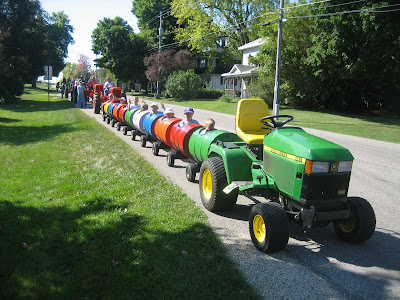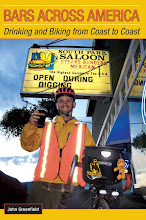
By John Greenfield
God bless the Bikes on Metra program. Since Chicagoland’s commuter rail system granted access to bicyclists a few years ago it’s become a whole lot easier to escape the city and get into nature without using an automobile. I’ve used the bike-train combo many times to get to state parks like Starved Rock, Illinois Beach, Chain O Lakes and Kettle Morraine and I’m still discovering new destinations.
Case in point was a spontaneous trip I took this week that inadvertently brought me to Shabbona (pronounced “SHEAH-bunna”) Lake State Park. It’s a pleasant little rec area 30 miles west of Aurora, IL, that I didn’t know existed until fate took me there.
I’d actually been planning to camp at Silver Springs State Park, 16 miles southwest of Aurora on the Fox River, having decided the night before to take advantage of the gorgeous late September weather by getting out of Dodge. I’d heard of Silver Springs because it’s across the river from the steel-and-glass Farnsworth House, designed by Ludwig Mies van der Rohe in 1951.
After loading up with full camping gear I caught the train Tuesday morning at 18th and Western heading to Wayne and Garth’s hometown. Eventually there were a total of seven bikes in my car which required some shuffling as cyclists exited at different stops.
At around 175,000 people, Aurora is Illinois’ second-largest city, located at the western edge of Chicago’s suburbs and bisected by the Fox. Next to the Metra terminal is Walter Payton’s Roundhouse, a very serviceable brewpub set in a historic building, originally used for servicing locomotives.

I took a quick spin around the downtown, checking out the old firehouse, topped with an onion dome; sculptures of shrouded female figures on the 1931 Memorial Bridge; the garish Hollywood Casino riverboat; and the ornate Paramount Theater. Then I got on the paved Fox River bike trail heading southwest out of town.
Unfortunately, while in Aurora I forgot to visit the Dr. Charles Smith’s African American Heritage Cultural Center. It’s a sculpture garden and studio with more than 400 works depicting black history, which I’d read about in Jerome Pohlen’s
Oddball Illinois. Oh well, there’s always next time.
The 33-mile trail bike path runs north-south from Crystal Lake to Oswego with a handful of Metra stops along the way, making it a great place to take a car-free pedal without resorting to roof-racking. It also meets up in several places with with the 61-mile, crushed-limestone Prairie Path system which fans across the ‘burbs, so there are many possibilities for day rides.

After picnicking on a river island I stopped in Oswego at Millrace Cyclery, a well-stocked shop, to pick up a spare tube. Detouring off of busy Rte. 71 I found myself in Farm Colony, a new development full of McMansions and SUVs where once there were cornfields. Next to a man-made pond with Canada geese a sign warned, “This neighborhood is for exclusive use of Farm Colony residents. All other will be considered trespassers.”
I passed through Yorkville and soon found myself at Silver Springs, where burley worker were setting up tents for this weekend’s National Hunting and Fishing Days. The event features shooting ranges, canoe rides and the Hawg Trough, a giant fish tank hauled in on a semi, used to demonstrate angling technique.
Unfortunately, the lady at the snack stand told me that, despite the tent icon on the Illinois map, nowadays Silver Springs only offers camping for youth groups. Since the campground was sure to be empty on a Tuesday night, I thought about waiting until dark and guerilla camping anyhow. But the scenery at the park didn’t seem too spectacular, so I decided to soldier on to Shabbona Lake, 26 miles northwest, which she recommended for camping.
I stopped at nearby headquarters for tours of the Farnsworth House, a one-room house in by the Fox River, with exterior walls made almost entirely of glass. Chicago kidney doctor Edith Farnsworth commissioned the structure from Mies van der Rohe as a retreat in the woods where she could play violin and translate poetry. The two were rumored to have had an affair but eventually the relationship soured and a disagreement over payment led to a lawsuit.

Last year I took a bike and Metra daytrip with my friends Josh and Lisa to tour the structure, but the place suffered major damage when the house flooded recently during Hurricane Ike, even though Mies had it built on stilts for just such an occasion. At the HQ, site director Whitney French told me renovation costs may hit $500,000.
Crews were able to able to salvage most of the furnishings but the wooden core of the building became badly waterlogged. Although tours are cancelled for the rest of the season, French is confident the house will eventually open again. “There’s too much love for this house for it not to be restored,” she says.
Making my way towards Shabbona Lake, I passed through the town of Sandwich where Ketty’s Pub and Grill is partially housed in an old railcar. As I stair-stepped northwest on the grid of back roads lined with corn and soybeans I savored the sight of the sinking sun. With no buildings to block the view, the sunset over the prairie wasn’t so different from those I’d enjoyed on the west coast of Michigan a few weeks earlier.

I stopped in the tiny town of Shabbona to pick up some groceries before setting up camp at the park, stopping for a drink at Nite Crawlers tavern, a dive with a beautiful carved wooden bar. Almost everyone in the place was wearing t-shirts and drinking bottles of cheap beer so I drank PBR as well. But the guy next to me, the owner of the local hardware store, was wearing a polo and drinking Sam Adams Octoberfest on tap – as the resident beer aficionado he had lobbied the bar to stock it.
We got in a conversation about the ancient roots of brewing. He said the Sumerians wrote on clay tablets about making barley beer long before they wrote about baking bread with the grain, so fermentation may have been one of the chief motivations for civilization. Then he asked why I was drinking swill. “I don’t want to look like a snob,” I said. “Be who you are,” he advised.
Making my way to the wooded campground littered with horse chestnuts, I pitched my tent in the dark, heated some soup on my canister stove and soon hit the hay. The next day I packed up and explored the area surrounding the mile-long, man-made lake, created in 1975 with the construction of a 3,000-foot earthen dam. The lake is well-stocked and fishing seems to be the main attraction. Small cabins are available for rental, which might be a nice option in the winter when trails are open for cross-country skiing.

Towing my loaded bike, I strolled along the Arrowhead trail which skirts the lake through prairie and deciduous forest with occasional views of the water, spying deer, butterflies and hawks along the way. Then I rented a rowboat for ten bucks and rowed across the water. Dead trees, left over from the days before the land was flooded, stick out from the surface like bony fingers. On the far side of the lake I spotted a big blue heron that flew into the air with a screech when I pointed my camera.
After I docked the boat and continuing on my hike, the scenery changed to piney woods then marshland full of cattails waving in the breeze. At 3:30 I got back on the bike and headed northeast 17 miles to check out the city of Dekalb, home to Northeastern Illinois University. A billboard along the way showed the winged ear of corn logo for the famous Dekalb brand with the legend, “Dekalb County is DEKALB Country.”

As I headed into the quaint downtown, signs directed me to the Egyptian Theater, which opened in 1929 during the first wave of King Tut mania. The outside façade, with its pastel bas-reliefs of pharaohs, is very reminiscent of the Reebie Storage and Moving building in Chicago’s Lincoln Park. The theater was closed but operations director Alex Nerad heard me yanking on the doors and invited me inside for a tour.
The inside of the theater, which still shows movies and stage shows, is stunning with its many gilded heads and statues of Ramses, murals of sphinxes, palms and pyramids and a ceiling of twinkling stars. Nerad says there used to be around 60 Egypt-themed in the country but the Egypt is one only six left standing.
He says the theater is trying to raise $2.5 million for renovations including adding air condition and new seats. “These are the original seats from the 1920s and they just weren’t designed to hold people as wide and as heavy as what’s common today,” he said. This weekend the theater is staging its first “Ride Like an Egyptian” benefit bike ride to raise funds for the work. I’m sure the Bangles will be in heavy rotation on the sound system.

It seemed liked every other person in Dekalb was walking down the street with a guitar. A young man was hanging out in front of the House café on the main street playing banjo as the café’s owner, a bushy-bearded man in a fedora, scooted around the sidewalk on a Rollerblade Razor.
Down the street I stopped into North Central Cyclery, a big shop with a great selection of stylish bike commuting and touring gear like Surly bikes and Brooks leather saddles and saddlebags. The sun was setting by then and Toby, the owner, advised me to take Keslinger Rd. 19 miles east to the little country town of Elburn where I could catch Metra home, instead of riding all the way to Geneva as I’d been planning.
Keslinger was dead-straight and I had a tailwind, but the ride was a bit spooky in the dark as lightning flashed in the pink sky over the metropolitan area. When I got to Elburn I was surprised to learn that while train tracks run through the tiny downtown, the Metra station is just east of town, surrounded by nothing.
When the line was extended from Geneva a few years ago, residents opposed placing the station in the business district, where it could have boosted the fading local economy, because they feared the additional train and car traffic. Another opportunity lost to NIMBY-ism.

To kill some time before the 9:25 train, I stopped at Alice’s Place, an ice cream shack that’s been open since 1958, originally called Dairy Joy. Before Alice took it over 16 years ago and cleaned it up, locals called the place the the Dairy Dump. I sat inside at the counter and ordered a fried pork tenderloin sandwich, difficult to come by in Chicago but more common as you get closer to Iowa.
After a rush of excited high school kids at the takeout windows, Alice told me how the young couple next to me met. The young woman worked the counter and the guy used to show up every night after work for dinner. The girl used to make fun of him, Alice said, but eventually they got married.
As I sat there in the quiet Elburn night before catching the gleaming stainless steel train back to the center of the big city, I was struck by the power of rails and bicycle wheels to connect the urban with the rural.








































